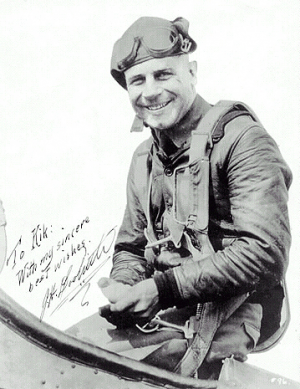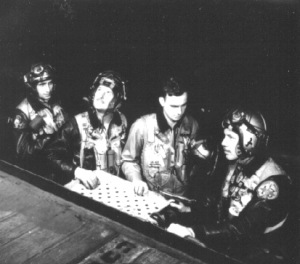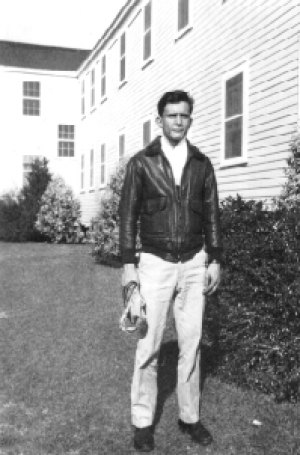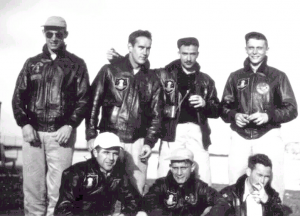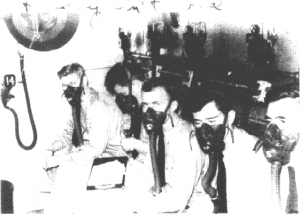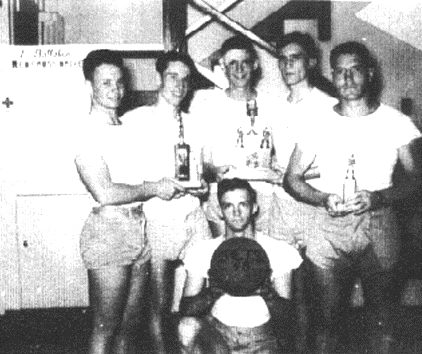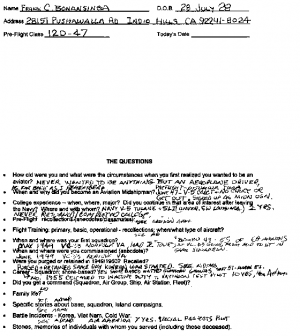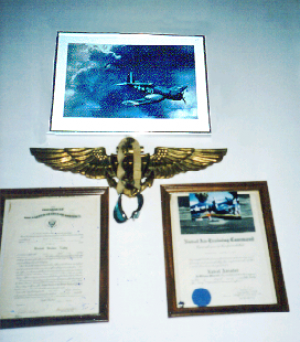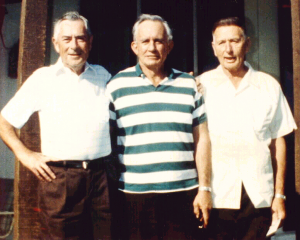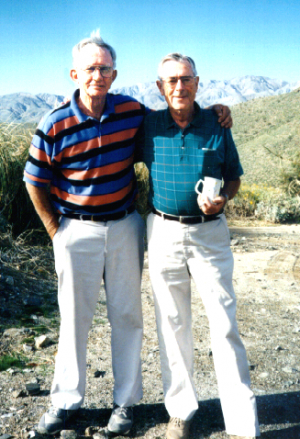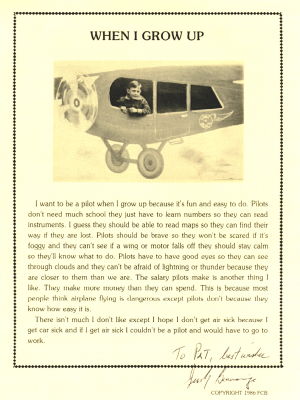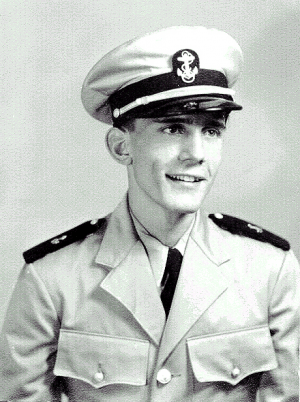 Early Influences
Early Influences
My mother put in my baby book that I was always pointing to birds, aeroplanes, anything flying and smiling. Perhaps I was formerly of avian heritage!
An Aunt who baby sat me said she and her boy friend often drove to a nearby farm fields to watch the “barnstorming flyer” of the late 20s and early 30s near Sioux City.
My first airplane ride was in an open cockpit biplane Easter Sunday 1935 in the Los Angeles area that I remember. I begged to go up again and was granted another flight.
Most Influential Person
In 1936, I met James H. Doolittle during a large aviation exhibit in Pan Pacific Auditorium next to the Gilmore Stadium. All the planes landed on the parking lot between them and taxied into the huge auditorium. Doolittle was chief pilot and a vice president of the Shell Oil Co flight department. He autographed a picture of himself in flying gear and gave me a pilot’s pen light that is long gone. The picture is autographed to “Kik” my nickname as kid that I got rid of when I got my first knickers a year or so later.
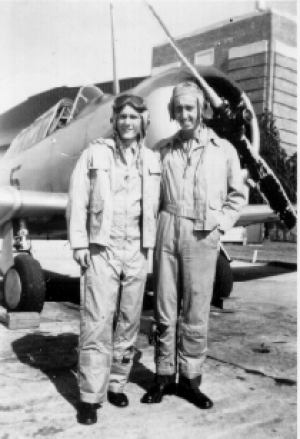 In 1942 when Doolittle led the perilous B-25 mission of the Hornet, I told my classmate I knew him and they somewhat doubted this, to put it politely. In 1964, I wrote to tell of his influence on me and that I had just been voted into the Society of Experimental Test Pilots. (General Doolittle was an honorary member of the SETP as the world’s first instrument pilot, among many other feats).As most kids in our era of the 30s, we made balsa wood, rubber band propeller powered tissue paper covered flying models that ended up getting burned up in a glorious “crash”! We also made & flew our own kits. We constructed scooters out of orange / apple crates, carved out and spun tops and played marbles. Most of us had a bb gun, shot cap pistols, carried a pocket knife and were in a “our” gangs.
In 1942 when Doolittle led the perilous B-25 mission of the Hornet, I told my classmate I knew him and they somewhat doubted this, to put it politely. In 1964, I wrote to tell of his influence on me and that I had just been voted into the Society of Experimental Test Pilots. (General Doolittle was an honorary member of the SETP as the world’s first instrument pilot, among many other feats).As most kids in our era of the 30s, we made balsa wood, rubber band propeller powered tissue paper covered flying models that ended up getting burned up in a glorious “crash”! We also made & flew our own kits. We constructed scooters out of orange / apple crates, carved out and spun tops and played marbles. Most of us had a bb gun, shot cap pistols, carried a pocket knife and were in a “our” gangs.
Movies etc.
The movies such as Wings, Hells Angels, The Dawn Patrol and Test Pilot were seen twice the same day, which was allowed then. The Saturday morning serials shown before the main feature often had flying thrillers all future pilots loved to see.
“Jimmy Allen” was an afternoon radio program about a teenage pilot that I listened to daily. The Orpheum theatre had “Jimmy Allen in person” on the stage and my parents took me to see him.
There was Tail Spin Tommy big little books and other flying characters I read daily in the comic strips. The comic books were just coming out. The first TV set I saw was probably some ten years in the future about 1946.
Also in the Los Angeles area about 1935-36, by the La Brea Tar Pits, there was a gasoline filling station that had a MB-2 or similar WW One open cockpit bomber parked at the filling station. My Dad would fill up so I could go inside it, every time of course.
About the same time, we went to see the Thompson Air Races the year it was held in the LA area. I can remember seeing hundreds of parachutist landing nearby. And the racers flying low around the pylons. There was a fatal crash but I still wanted to be a pilot.
Greatest Hero
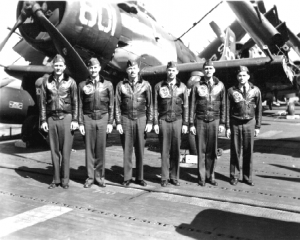
Finally, Charles A. Lindbergh was my hero. His solo trans-Atlantic flight in 1927 and still a head shaker and the most remarkable feat ever done by a human, to me.
He flew having to stick his head out of a sidedoor hatch or using a periscope for forward vision as his Ryan had no windshield! Awake for nearly two days, he had to manage his fuel by switching tanks and adding engine oil in this unstable plane to keep it flying.
There was no auto pilot to help him fly or rest! He flew into dangerous icing conditions, in clouds, at night, fighting vertigo and spinning in, before instruments for “blind flying” were invented. (The world’s first instrument flight was by Jimmy Doolittle in 1929).
The flight was before navy aids, winds aloft reports, radar tracking, IFF and computers were around to show way points. He crossed the Atlantic with a clock, air speed indicator, watching the waves, a compass and excellent preflight course planning on his 33 and a half hour flight. Lindbergh’s feat is my first place for medal winner of human courage and as brave as any explorer. Quite possibly the first person who ate an artichoke, should be honored with a brave eater’s medal.
Jimmy Doolittle as mentioned before, made a personal impression on me. He also was the complete pilot with the first Aeronautical degree in engineering ever bestowed at MIT. He was the pioneer test pilot in the field of instrument flying and other fields of aviation including engine performance with aviation fuel, and was a pilot who was at ease flying any kind of airplane and set world speed records in land and seaplanes. He was the pilot’s pilot.
The only thing, kind of person or job I ever wanted from as early as I can remember, was to be like an aeroplane pilot, fly airplanes and follow in their footsteps. This was granted and I too was lucky.
Frank C. Bonansinga born 28 July 28.
Preflight class Ottumwa 12-47 graduated Pensacola 1 Nov 47.
Designated 13 April 1949.
New Wings
I was one of 10 proud designated Naval Aviators, photographed that 13 April 1949 at Cabaniss Field near Corpus Christi Texas. I flew the F4U – qualified aboard the USS Cabot Corsair in advanced training.
Soon after receiving the coveted gold wings, I was enjoying a beer at the popular Sazerac Bar in the lobby of the Roosevelt Hotel in downtown New Orleans just off Canal St.
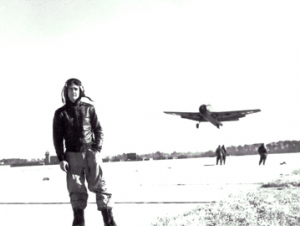
Two Naval Officers, both aviators, pulled up next to me and ordered a drink. We were in summer khaki uniforms with blouses. They saw the unusual looking shoulder boards and the Naval Aviator wings on this very young looking person.
They looked at each other, then looked back at me and asked, "What are you?"
First squadron
After home leave, the ComNavAirLant assignment officer assigned me to a newly recommissioned ASW squadron, VC-33 at NAS Norfolk. But first there was school at the Fleet Aviation Electronic Training Unit for a short course in radios, radar, sonoboys etc. equipment.
Commissioning
Mid’n Jurgen H. Miller was the first Midshipman to report and I was next to check in at VC-33 on 13 June 1949. We were commissioned Ensign USN, 25 June I, 1949.
On 30 June, Jerry and I flew the TBM. After flying the F4U Corsair in training, the Avenger was definitely truck like and we developed strong right arms. But the “Turkey" was a good carrier aircraft and we enjoyed the flying. Our squadron tail and wing marking, was SS or as referred to then as Sugar Sugar.
The Skipper
Cdr Robin M. Lindsey, VC-33's commander, was a soft spoken man, well known for his service as LSO on the carrier Enterprise (CV-6) in WW II. During the Battle of Santa Cruz in Oct 42, he manned a rear gunner's seat of a parked SBD and downed a Japanese dive bomber. Enemy bombs had knocked out the Hornet. Now the Big E was the Navy's only remaining active carrier. And it had a huge gaping hole in the flight deck where a bomb had hit. Lindsey cut the last returning planes on a jammed packed deck to the #1 wire, all safely recovered.
Lindsey, prior to his VC-33 command, served as the CO of the Carrier Qualification Training Unit at Pensacola. Lindsey was considered possibly the finest LSO the U. S. Navy ever had.
Fuel Rationing
In 1949 because of government cut backs, all squadrons had limited fuel allowances. To get the most flight time, Commander Lindsey recommended using low RPMs and high manifold pressure yet below the max BMEP (engine pressure) allowed. This technique, correctly used, avoided detonation.
The squadron's excellent results in high flight time would be a factor in being chosen to assume the Night Attack mission from VC-4 and not be decommissioned.
Experience
Our TBM squadron had 33 officers with 32 pilots. There were 14 experienced pilots. Of the 18 inexperienced pilots, 11 were former midshipman. Lcdr Pratter, our exec, was a multi-engine pilot and recently completed advanced in Corsairs and like the rest of us, had no fleet carrier experience.
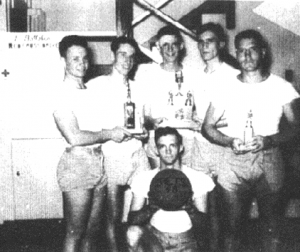
Tactics
Cdr Lindsey often had his squadron follow him off the large circular tarmac at NAS Norfolk in formation take offs. We also would land in formation; just like in the movies and it was no "big deal".
Deommissioning News
Less than four months after recommissioning, Cdr Lindsey notified the squadron it would be decommissioned within a few months due to additional budget cutbacks. It was same day, the 24th of September 1949, our squadron group picture was taken in front of three TBMs with the Sugar Sugar SS markings parked at LP-3.
Flight Gear
Just before my first hop with Dwight Mahaffey (in summerflight gear) NAAS Corry Field Pensacola, FLA. Airplane is North American (Texan) SNJ-4 Trainer P & W 650 HP engine
In 1949, flight gear consisted of cloth helmets with glass goggles, leather gloves and flight jackets and a white scarf. Later that summer, a light nylon green flight suite was first issued. It was soon recalled after several melted in fires! So back to the tan summer flight suits.
During the colder months, we wore leather jackets, helmets, gloves and heavy boots, all fur lined. The TBM and most WW II aircraft we flew were quite breezy; actually more like flat ass cold.
Later at NAS Glenview during the winter of 1950-51 at NATTU, we flew the F8Fs during the day and F6F-5Ns at night. We wore electrically heated flight suits that made flying there near comfortable. The southern end of Lake Mich-igan froze over that winter. The snow was piled higher than the parked F6s and F8s for weeks.
Rope Yarn Sunday
Our Skipper believed in taking an occasional Wednesday afternoon off, referred to as Rope Yarn Sunday. After the morning flights were secured, all but the Duty Officer mustered at a recreation site on the base. A couple of kegs of beer, soda pop and plenty of sandwiches were supplied.
Once after a softball game Lindsey said anyone who could throw a softball farther than he, would get a 72 hour pass. Only one of the Ronecker brothers out-distanced the skipper's throw and he gave both brothers a long weekend pass. The half day off was made up working Saturday morning.
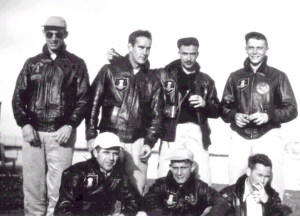
VC-33 First Cruise
The first cruise was on a shake down cruise aboard the FDR (CVB-42) to Guantanemo Cuba called Gitmo. Our exec, CDR Putt Pratter hit the ramp on his first pass. The early morning sun was directly in his eyes at the cut and was a major factor in this tragic accident. The skipper was airborne, landed as soon as the deck was cleared and went to the LSO platform and brought the squadron aboard.
Though a tragic restart for the squadron it was not a bad omen, as VC-33 wasn't decommissioned until in the mid-1990s after some 40 years of distinguished service.
Visits
We were invited to the Captain's quarters for drinks and conversation. Commander Lindsey and his wife made their invitations always enjoyable and sometimes most interesting.
On one occasion a few of us were present when CDR Clarence Wade McCluskey, a highly decorated SBD dive bomber pilot from the battle of Midway fame and Cdr Lindsey talked of experiences aboard the Enterprise in early WW II.
Breezy Pt. O Club
We'd meet at the O Club after the squadron flight operation and play dice games of Ship Captain and Crew and Liars Dice; also Cardinal Puff was played for drinks. Sometimes old navy songs, not yet published, were sung.
We each made our low freq radio range approach and landing. After parking and securing our TBMS, we asked if we might get some refreshment and food. They told us all the clubs were closed on Sunday nights at Chincoteague, (probably off base too). Our pax large round-faced bird Colonel
from the War College declared war and said he wanted it opened! He wanted a drink. We did too. Those eagles he wore proved that rank has its privilege!
We were soon having a couple of beers and something to eat at the O-Club. Jim confessed that most of his instrument lights had gone out and he had to hold a flash light in his mouth while making his approach!
The next morning when the fog burned off, we returned to Norfolk. We could have heard a few words about the incident. But No! The skipper had the squadron instrument officer LTjg Frank Wikenheiser give us instrument check rides. We were issued the Navy's Single Engine Type Standard "White Card" Instrument rating dated 5-17-50. We each had about 800 hours flight time. This was our last flight in Norfolk flying for Composite Squadron Thirty-Three.
VR-31 and the Bearcat
The day after getting our White Cards, the nine of us to be released were ordered to VR-31. Our first flight was to ferry the Grumman F8F Bearcat to the Navy's graveyard in Arizona. We read the Bearcat handbook, sat in the cockpit for an hour or so and took a blindfold cockpit test. Checking out in an aircraft was far less complicated in 1950. It was accomplished rapidly and kept simple. The Naval Aviator was given considerable latitude on a fam flight in those days.
The 22 May 49, the five of us taxied to the end of the 2600 foot strip at Chambers Field by O&R for our first take off in the Bearcat. The F8F was the hottest and fastest Navy prop machine around. It had the world's time to climb record to 10,000 feet of 100 seconds. This feat lasted till a Douglas F4D after-burner jet a few year later beat it. The F8F leaped into the air so rapidly, if the gear wasn't retracted immediately, it wouldn't come up; going too fast.
Fran Klinker was lined up in front of me. He was cleared for TO and proceeded to do a slow roll on his first take off! What a hot shot or something like that I thought.
The F8's aileron controls had been rigged backwards at O&R! Fortunately, Fran was a quick learner and brought it back without further ado! One short interesting fam flight for starters.
On our first ferry flight and the two following, we stopped off at Briggs AFB in El Paso where the monster B-36s parked. We'd cross the border at Juarez and purchase spirits. Most of us picked up the large jugs in the wicker baskets of Cuban in memory of the Gitmo cruise.
After the trip out to the Litchfield Park, we rode a R4D Gooney Bird fubir flight back to VR-31. We played cards and slept as usual. At Maxwell AFB, our
last RON stop before departing for Norfolk, they politely told us to "never return" after we probably partied to excess.
The VR-31 R4D ferry crew told them not to worry as these wild sea birds were soon to be purged in the unknown of civilian life and trouble them no more; so all thought.
Purge Day
A day or so later, while in line for final discharge pay and walking papers, an orderly from ComNavairLant's office appeared saying the Admiral wanted to see all the former midshipman aviators being discharged, topside! We couldn't refuse and without some curiosity, headed topside.
Put at ease in his large office, we heard Admiral Felix B. Stumpf tell us there was a war in Korea! He thought kicking us out was a mistake and wanted us to stay in. And said he'd already talked with Washington about keeping us in the Navy.
He stated that he would finalize the proposal with Francis P. Mathews, then Secretary of Navy and we could request release to inactive duty and receive it at any time! His final proposal was that, we could return to our first squadron or go elsewhere.
Admiral Stumpf's proposal was accepted by most of us that day. The only part of his proposal that didn't happen, was not one of the returning VC-33 ex- Flying Midshipmen who volunteered to go to Korea, did. (We were eager and bachelors. The married pukes, as we respectfully referred to them, were sent and we were very young and never could figure that one out.)
The 11 VC-33 Flying Midshipman from Norfolk
1949-50 Purge and Korea War Era
Waldo Born Retained USN Retired
Jim Whyte Retained USN Killed on Active Duty
Following were to be purged 26 June of 1950 at Norfolk
and volunteered to return to VC-33 Atlantic City NJ
Art Barie Returned 3 July 50 Retired USN
Jay Keller Returned 3 July 50 Killed on active duty Vietnam
Francis Klinker Returned 3 July 50 Retired USN Deceased
Jrry Miller Returned 3 July 50 Retired USN
Jim Patton Returned 3 July 50 Aircraft Mfg & NASA test pilot
Frank Bonansinga Returned 3 July 50 Raytheon test / Air America pilot
Albert Doles Returned Later in 50 AEC Electronic Engineer
Rob Hancock Returned Later in 50 Caterpillar Co. Engineer
William Wroth Went to another Squadron Killed on Active Duty
Atlantic City NJ
All Weather Attack Squadron VC-33
The day after rejoining 33, the six former 33 FM and FM Robert Holden from another VC TBM Norfolk squadron checked out in the Skyraider at NAS Atlantic City. As before there was no cockpit simulator trainer. Had to read the handbook, sit in the cockpit, take a blindfold test, pass a written test, then fly it.
The Douglas Skyraider had modern things, like an easy opening canopy, dive brakes and aileron boast that didn't require brute strength and was easy to fly. It was simple to land, and fast too. A good machine. Douglas even gave us a lighted kneeboard with a pencil sharpener that I have after almost fifty years. Later when I was to fly their F4D Skyray, they supplied fancy boots. Those, I don't have.
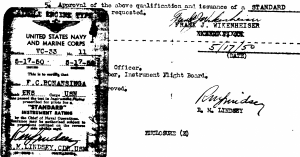
FCLP
Field carrier landing practice was just that, flying low and slow making full stall landings on the runway preparing for the real thing. We flew 300 feet or so above the ground and made 8 passes and if the LSO thought we looked good he cut us for landing; if not, he waved us off.
The LSO kept a shorthand type log of each approach and landing. A wave off was WO. A roger pass was a good pass was marked OK. Too fast was F, S was for slow, DNIG was dropped nose in grove. TAW was turning all the way. FATB was, fast as two bastards, and DNKUA, was damn near killed us all. When available the LSO used a radio and would say something similar to "what the hell are you doing, slow it down". The radio was seldom used.Waving was interesting and sometimes required quick feet to save one's behind. Giving signals was almost a sixth sense, judging by sight and sound of the approaching aircraft; when to cut the pilot to land and when to wave him off.
That Infamous NJ Insect
The humongous Garden State mosquito defied description. All of us suffered from their bites given between FCLP periods, standing by the LSO out on the runway. Nothing deterred them regardless of how much or what brand of stay-away juice used. Some was bad and some smelled worse but none of it kept them away.
Night Carrier Flying
There's something about night, darkness and flying. Only bats fly at night and in all kinds of weather. They succeed because they sleep upside down, in the day and aren't birds. Unfortunately we don't possess their radar like night vision and radar avoidance equipment. The day pilots who are more normal like regular birds don't fly at night and considered the night pilots a bit batty! Probably right too.
It took me 9 night FCLP periods and 58 practice landings before the LSO said go out and don't kill yourself or bend metal. This compared to 4 periods and 26 landings before going to the USS Boat to day qual. Night carrier work was considerably more demanding for all, pilots, aircrews and the carrier crews.
Four of us were ok'd to fly out to the USS Palau (CVE-122), an escort carrier the afternoon of 17 August 1950 for our first night landings. We made a couple of day landings and take offs late that afternoon on the Palau. Compared to the CVB, the CVE was a midget! The CVE, the smallest of aircraft carriers was referred to as a "Jeep.” It's 600 feet long and a football field length shorter than the 926 foot Midway CVB.
In this era before the canted deck carrier, there was no touch and go or go around option. Get it right the first time or crash day or night.
After the two day landings, we were debriefed by our LSO. The ship's crew made us feel most welcome. We were served a fine meal before getting night adapted wearing the red goggles in the ready room waiting for darkness. As true bats, we did not attempt to night qualify till it was dark.
Unfortunately it wasn't good for night carrier landings that August evening in 1950. The weather was good. It was hazy, no moon and pitch black but OK for night carrier landings. We launched and started our night carrier approaches.
The no wind was a no win situation. The CVE couldn't make enough speed to give the needed wind over the deck for the Douglas AD-3Ns and 4Ns to land on the Jeep except for six arrested landings!
So after almost two hours of round and round, the LSO sent us to the beach with tail hooks dangling. As we landed, the sparks went flying down the runway. The Navy Quonset Point tower operator kept telling us, "your hooks are down, your hooks are down". We said, we knew it; nothing we could do, taxied in and had them put up manually.
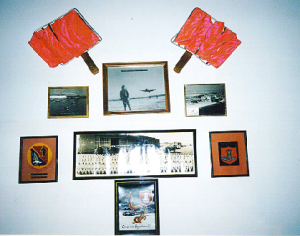 The four of us retired to the BOQ bar in flight suites to discuss the evening's work. We agreed that Skyraiders and CVEs just don't work. The Navy also realized the same thing and CVEs were soon no longer used for AD night quals.
The four of us retired to the BOQ bar in flight suites to discuss the evening's work. We agreed that Skyraiders and CVEs just don't work. The Navy also realized the same thing and CVEs were soon no longer used for AD night quals.
In reviewing my log books I had but 11 cat shot take offs. Only one is recalled, the Palau night cat shoot after the night landing. It was one big kick in the butt from the littlest carrier.
Composite Squadrons
Prior to converting to the canted deck aircraft carriers, each carrier had small detachments of pilots mainly flying night and all weather missions from composite or VC squadrons.
The VC-12 team was based at Quonset Point RI, flew the Guppy Skyraider early warning radar trackers. Flying F4U-5N and the F2H-2Ns, the VC-4 night fighter detachment and our VC-33 AD-N night attack team were both based at Atlantic City. The VC-12 team was based at Quonset Point RI, flew the Guppy Skyraider early warning radar trackers. Flying F4U-5N and the F2H-2Ns, the VC-4 night fighter detachment and our VC-33 AD-N night attack team were both based at Atlantic City. The west coast had similar Composite squadrons/ aircraft operating in the Pacific. The VC photo team that for obvious reasons, flew only in daylight conditions and also were on each carrier.
The night teams were at times referred to as the Cats and Dogs! The name was perhaps from when they flew, "it's raining cat & dogs". Or cats and dogs need to be put out at night; they do it at night, or whatever the reason. The VC aircraft usually flew singly and didn't join up until just before recovery.
Night Lighting
At night, depth perception on the flight deck was obtained from a series of lights referred to as "dust pan" lights. They were turned on as the plane was in the groove or just before the "cut" signal from the LSO. The dust pan lighting system was poor at best and landing at night was a very mechanical act that had to be learned, repeated so that the more you did it the easier it got. It was difficult at best.
The center line lights on the carriers deck were so small they couldn't be seen. LSOs attached a vest light to wires along the center line to give the pilots a line up reference. It helped.
Landing at night on the axial straight deck carrier was something like trying to drive down a two lane asphalt road going 100 miles an hour with no head lights, only parking lights to see. The road had no center line markings. If it rained, things got interesting.
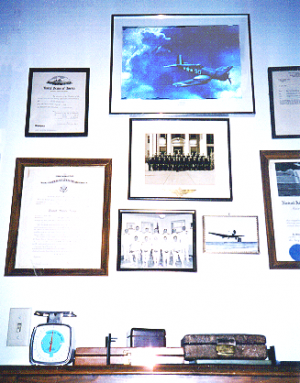 Night Landing Signals
Night Landing Signals
The LSO waved or signaled giving speed, height and line up signals similar to the day except from ultraviolet lighted flags, florescent like wands, or a Christmas Tree lighted suit. All were tried.
These various suits worked well except when visibility was reduced by smoke, haze, fog or rain. Then the LSO's signals were often not seen till close in. Rain compounded the problem blurring the signals, through the windshield as we had no wipers.
First Tour: see log from FDR Med Cruise 1951
Departed NorVA January 51 VC-33 Det 7
Second Tour VC-33
In July of 1952 I returned to VC-33 in Atlantic City. The squadron wasted no time and requalified me for day and night carrier landings in the AD-4N in a couple of weeks.
On the 27th August the USS Midway (CVB 41) left Hampton Roads VA with a 33 night attack team Det 5 Lt Roy Janiec 0-in-C, to participate in Oper-ation Mainbrace. This first NATO joint exercise was to be staged above the arctic circle off Norway.
The rubber survival flight suit was worn and required assistance to don and get out of. Lots of talcum powder helped, but it was most uncomfortable and hot, a real pain in the end.
Fortunately no one had to prove the "poopy suit" worked in the cold waters off Norway. We flew 4 night missions per pilot which was more than normal! The Midway did some "big time" rocking and rolling and a couple of the night landings were most interesting. The view of the fjords in Norway where my mother's folks came from and aurora borealis were both spectacular. Some even thought they saw UFOs but I believe the fantastic dancing pipe organ northern lights were the UFOS.
After completing the exercise, we pulled into Cherboug, France before heading home. I received a telegram that Robin Elizabeth Bonansinga our first daughter was born that wonderful day, 26 Sept 52.
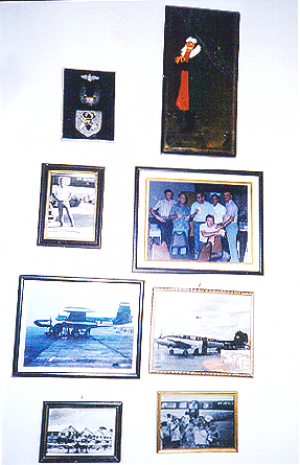
Tarawa, Second Med Cruise
Jan - June 1955
In 1953 the Tarawa CVA 40 departed Quonset Pt. RI. for the Med with 4 AD4Ns and 1 4Q Sky-raider with 6 pilots of VC-33 Det 32 LT B. J. DeCoux 0-in-C. Our night team flew more often making more night landings than in my previous cruises averaging one night mission a week. During my first Med cruise in early ‘51, we rarely flew at night. In the four months we averaged one landing a month!
What I remember most was Win Estes, A. B. Wilson and I shared a bunk room far below deck. It was like a tomb. We were next to the catapult engine and could hear a click a second before it sounded like a cannon going off. We actually could sleep through it. Our team played monopoly often and there was cheating by some, perhaps me too. Windom always won if Alexander Blake didn't. The Tarawa visit to Barcelona was epic and near ruined Spanish American relations. We were the first CV to pay call there.
Prohibition?
The flight surgeon would meet the aircraft after a "hairy" night flight with a sample size bottle of medicinal spirits. This profound act of mercy was most appreciated. The British and French carriers had a 19th hole, mini O club that was always open after flights, hairy night or day CAVU. Our navy had discarded the grog ration many years before.
Third Med Cruise, Intrepid
The USS Intrepid CV-11 left Mayport on 22 May of 55 with 4 AD-5Ns and two AD 4Qs of VC-33 Det 32 Lcdr R. G Armistead 0-in-C. The 5Ns did all the things the AD-4Ns did but took more time doing it. The crewman liked the new
5N cockpit arrangement as they weren't strapped to the claustrophobic innards of the 3N and 4N but could see what was happening, especially during take off and landing.
We used the AD-5N on low level pathfinder flights we called "butt busters". We flew low at 200 feet till making landfall, then a bit higher over land. One butt buster was from off Malta to Denmark and the second launched near Sicily to western Spain and return. The flights lasted 8 to 9 hours returning to the carrier at night after 2,000 miles of low level driving.
Somewhere on the flight physiological ladder, someone decided we should take a stay awake pill that would make us alert for the demanding night landing. Unfortunately after taking it, sleep was impossible till sometime the next morning we learned. The normal reaction to making a night carrier landing was enough to keep a mummy awake! No more pep pills were taken.
"Someone"
It was near the end of my active duty days on aboard the Intrepid off the Bonansinga old homeland, Italia. My AD-5N was spotted on the number one launch position that morning. With two experienced crewman, Friend and Olmstead aboard, the 3350 was advanced to full power and we started the normal deck run take off. But something didn't seem right.
We were going to dribble off the flight deck! We were not going to fly! We were going in!
And we couldn't stop in time. Not enough deck left; trying to stop was not an option! I heard the ship's crash horns blasting the CRASH CRASH yodel, that screaming sickening signal that we were going in.
As we dropped off the bow, I nosed over hoping the safest bit of speed might equate to extra lift, might get us through this one. At the same time, the gear handle was yanked up!
The Med's surface never looked so near without going in. If salt spray was on the windshield, I don't remember, but we certainly were entitled to a "closest to the water" ribbon.
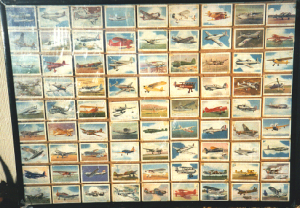
We all have experienced fear, been frightened before. Upon realizing with unbelievable relief we were going to fly and not float, I got somewhat irritated thinking someone had tried to kill us! We made our flight. Not much was said between us and what was, wasn't printable. I was upset. Immediately after shut
down, I headed for the bridge. Fortunately for me, the Air Boss and ship's Captain made a halting hand wave signal and were first to speak. They both knew I was getting out in a few days besides.
A slight error had been made by someone I was told. Seems that old "someone" had read the deck run take off distance chart incorrectly and had looked under AD-4N or AD-4Q for my take off that morning instead of an AD-5N we were driving.
The AD-5N with its super wide comfy side by side seating ala jumbo jet seating style also had beaucoup frontal drag. And it was slower than owl droppings to accelerate. And AD-5Ns were considerably over weight compared to its older, slimmer and lighter 4N or 4Q brothers.
All things considered, they had similar parts, skin and name. Skyraider was their call and Douglas was their name. But that was it. If that football length deck run was 10 yards less, it would have been, splash one Able Dog, 5N.
Six days and 7 flights later, my carrier flying days and nights were over. This is the only carrier take off I remember of 300 plus deck runs in VC-33.
Naval Aviation
I had arrived as a Midshipman in 1949, commissioned Ensign USN, then jg USNR in ’51 and then finally LT USNR in ‘54. All in the same squadron VC-33. My hours, landings, numbers are nothing compared to what others had done; and miniscule compared to what aviators achieve off the canted deck carriers. It was a different era, when night carrier missions were flown by but a few.
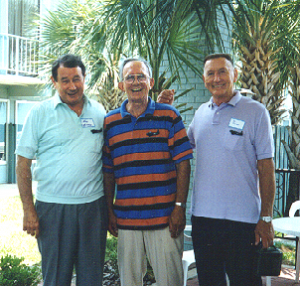
COMPOSITE SQUADRON THIRTY THREE
U. S. NAVAL AIR STATION
NORFOLK, VIRGINIA
17 MAY 1950/ (DATE)
From: Senior Member, Instrument Flight Board
Subj: Naval Aviation Instrument Flying Qualification
Ref: (a) Aviation Circular Letter 46-49
1. F. C. BONANSINGA ENS USN has this date satisfactorily
(Initials, Name, Rank, Classification)
completed all tests and examinations given by F. J. WIKENHEISER LTjg)
as prescribed in reference (a) for as
( ) RESTRICTED (Red Form NavAer 4120B)
(X) STANDARD (White Form NavAer 4120C)
( ) SPECIAL (Green Form NavAer 4120D)
2. This Instrument flight test was given in single pilot type/XXXXXXXXXX.
3. This pilot has a total of 821. 0 hours of heavier-than-air pilot flying
time, of which 237. 0 hours are actual or simulated instrument flying as
pilot. Of this total, 37.0 instrument hours have occurred in the preceding six months.
4. (For Special Instrument Rating Only). This pilot has consecutive
years of flying experience military and commercial
UNITED STATES ATLANTIC FLEET
AIR FORCE
COMPOSITE SQUADRON THIRTY-THREE
Care of Fleet Post Office
New York, New York
C-33NWB: he
13 Aug 1951
From: Executive Officer, Composite Squadron THIRTY-THREE
To: ENS D. G. RASKOB, 504429/13150 USNR
ENS R. C. ALLEN, 508625/1310, USN
LT P. M. BUDINGER, 337542/1315, USNR
LTJG R. A. HILL, 429986/1315, USNR
LT J. M. MC MILLLAN, 347287/1315, USNR
LTJG A. P. KEOWN, 471061/1315, USNR
LTJG F. C. BONANSINGA, 506146/1315, USNR
LTJG R. A. HOLDEN, 496774/1315, USNR
ENS B. KELSEY, 507099/1315, USNR
ENS C. B. Myers, 508226/1310, USN
LCDR W. T. PARKER, Jr., 105745/1355, USNR
LTJG J. M. PATTON, Jr., 506401/1315, USNR
ENS C. A. TAYLOR, 508486/1315, USNR
ENS B. T. WILBUR, 506719/1315, 1315, USNR
Subj: Miss America Contest
1. On the night of 8 September 1951, you will attend a social function as an escort for one of the lovelies entered in the Miss America Contest.
2. If you have any objections, please voice same immediately,
3. God be with you – I wish I could be!
N. W. BRIGGS Acting
This was vastly over-rated!
We couldn’t hold hands with them!
It was so ridiculous even the girls complained!
A No No Contest
The Miss America Contest in 1951 was to be held at the Atlantic City Auditorium on the Boardwalk, just as it had been since the roaring twenties.
The organizers wanted single males who could show up in Navy dress whites and could walk. A group from our squadron got "orders" to attend this gala affair. We had nothing to lose so all attended.
This thing lasted too long. Several times we went out for a beer. Finally after Miss Alabama was crowned, we escorted the young ladies upstairs. We expected to learn more than name, rank and serial number.
But no! There was no fraternizing, no getting to know you, and absolutely no dating afterwards, not even the next day! And other than a 7-UP, Coke or Orange Crush, forget it. Absolutely not! This was where the original no cal fake alcoholic drink was first conceived.
Besides the no drinking command, there was the no dancing command. Thus no music was heard in the no no room.
We sat at a table, like a conference table making the smallest of talk. It was similar to the Irish or Israeli peace talks, the UN or baseball negotiations or auto union labor relations talks.
I admit, we did get to touch them once, when we held their arms escorting them out of the hall. But only while wearing those pure white gloves! And it was a very clean and sanitized touch.
Not all the Miss America contestants liked this no no Nanette stuff. But it was too late!
Newt Briggs our personnel officer was trying to be funny with his jealous, "wish I could be there orders"!
He didn't miss a thing and was lucky he missed the "just say no" contest.
Med Cruise VC-33 Det 7, USS FDR (CVB-42)
Our team was lead by LT William Bill Burke USN, a blue eyed Irishman. Bill earned the Navy Cross during WW II for his part in sinking a Japanese cruiser. His pilots were, LTjg Al Meints and Frank Hemler. Ensigns Jurgen Miller, Robert Holden, Jay Keller, Dick Geist and Frank Bonansinga were former Midshipmen USN pilots now USNR. All had recently carrier qualified in the single engine AD, a Douglas Skyraider and were to fly aboard the USS FDR an aircraft carrier. It was January 1951.
The team's primary job was to fly attack and intercept missions at night in any weather condition. Secondary missions consisted of flying countermeasure, ASW and towing flights. With space for a crewman in our AD-4N and 4Q type aircraft, we sometimes were assigned personnel transportation flights.
This era of U. S. carrier aviation was before the canted deck or angled deck carrier, with it's escaping touch and go "let's get the hell out of here" option! And before the lens or mirror landing system that also helped make night carrier flying somewhat fun, was still a few years in the future. So for now, carrier operations was from the axial or straight deck ship with a Landing Signal Officer who gave signals with two flags or paddles. He waved the fast, slow, turn, low, high, or mandatory wave off (go around) or cut the power and land signals. A landing error usually meant a sudden stop, crashing into the fence of metal cables, a barrier protecting parked aircraft in the bow.
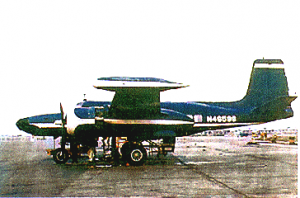
Carrier approaches/landings were visually flown including those at night. But at night a Destroyer was stationed approximately abeam the carrier to show the pilot where to turn in at night. Since helicopters didn’t fly at night, the Tin Can also had a rescue mission!
At night to be seen, the Landing Signal Officer (LSO) wore lighted suit and paddles. Sometimes it consisted of many white Christmas tree lights! Or ultra violet lights shined on reflective material on the LSO's flight suit and paddles! And fluorescent lighted wands were also tried. Whatever type lighting the LSO used, all were hard to pick up except in the best of weather.
Landing lights consisted of inverted "dust pans" lights that dimly lighted the boundary of the flight deck. They were turned on as the plane approached the stern, just prior to the cut signal. Thus there was poor depth perception for a very mechanical landing. Flashlights were placed on the deck's center line to aid in lining up as we had no landing lights!
Understandably, 99% of the day pilots avoided night flying like the plague. The night pilots didn't fly enough to stay anywhere close to sharp! It wasn’t until
my second Med cruise aboard the Tarawa in ‘53, we flew more at night, became more comfortable and had fewer accidents.
Still, flying off the carrier at night had a psychological advantage. It made day carrier landings seem so simple, to me anyway.
About 1960, 4 years after I got out of the Navy, with the advent of the steam cats, the canted deck, radar approach system, and the brighter "ball" lens or mirror system, Naval Aviators were required to fly at night off the carriers. And still, few like night carrier work in 1995!
FDR Med Cruise 1951
8th January 1951. Ferried AD-4Q, tail marking SS # 33, Buno 124053 from Atlantic City to Norfolk. 1 hr flight. My collateral duty on Det 7 is Ordnance Officer and in charge of towing. Also party officer.
9th I went ape and bought a bunch of supplies at BX. A record player, 40 bucks worth of records; Benny Goodman's Carnegie Hall 1939 Concert album, many jazz and piano records. Also an 8mm movie camera. And of all things a hat! We were ordered to buy a hat as officers are required to wear civvies ashore.
Have a bad cold. That beer last night didn't help it am sure.
10th Upped anchor from Pier 7 Naval Base Norfolk VA. With full load of everything and everyone, by 1100 were up to 16 knots headed east. No flights today.
Learned dress blues must be worn to evening meal. Jerry Miller and I have stateroom 02149 which is just under the flight deck far aft. (Later learned we had an automatic wake up call during flight ops. When a plane landed over us it sounded like 16 tons fell on us!)
11 January 190 miles west of Bermuda
First day of flight ops. Lost a VA-25 pilot on the first flight this morning. His AD 4 went in after a deck run take off. Didn't see it. Knew the pilot, a former Midshipman, Joe Richardson one of twin Naval Aviator brothers. Burke and I flew tow hops. I towed for a couple of cans. They shot off the sleeve on the first run. On landing, took my own wave off; got too slow for comfort. Second pass was fair but took my own cut. Ed (LSO) was in the sun all the way. No complaints from LSO. Flew 4Q SS 34 BuNo 124042 Flt. time 2.4 hrs. Stevenson handled tow gear perfectly.
Ship is pitching and rolling considerably. Weather is nice just huge swells. Have a toothache. Movie tonight. Was one year ago today our first exec Putt Pratter crashed on ramp aboard the FDR off Cuba. Let's hope today's fatal one is our last for this cruise.
12 January ESE of Bermuda. Flight ops today.
Another day of events. Two barriers today. No one hurt. But still fences. Those who have and those who will have, tis said. Burke and I flew intercept hop. Circled for an hour and half. Waste of time except for flight time and landing. Ed said I was rough, nothing new. After flying into the drink, been hard for me to smooth out the way I used to be but as long as I get aboard the first pass and don't ding it, who’s to kick? AD4N SS#8 Buno 124144 Flt time 1.8
Was scheduled to nite fly but it was called off at last minute. No reason was given. Nobody knows why. Sure hope it's no indication of the ship’s future night flying policy. The more we fly at night the better we get and naturally it goes the other way too. Nice night too.
13 Jan. Mid Atlantic No flying for ship except one tow hop from our outfit. Jay (Keller) took it and had to land on the Wright. We had refueling so Jay will have to stay there tonight.
Weather is nice today. But the seas were rather heavy due to strong southerly winds. Ship rolling quite a bit.
Had my shots this afternoon. Like the army it was boom boom boom, and you’re finished. But try to lift your arms. We're all grounded. No flying for 24 hours.
Sometimes this bucket of bolts makes some queer sounds. For instance right now it could positively go as a train clipping along downs the rails. The rumble, the squeaks, the odd noises never stop. We are 14 to 20 knots now.
Got an intelligence briefing to attend tonight after that what else, the sack.
14 Jan. Sunday Mid Atlantic. No flying. Stormy!
We've been in the midst of a storm for 24 hours. Early this morning one man was washed overboard from another ship. Luckily a destroyer picked him up. Later this afternoon our helicopter made a daring rescue pick up, bringing the survivor to the FDR. The severe rolling and pitching made the landing difficult and many many attempts were necessary before a landing was completed.
Tonight at 0230 we will make a max power run. This full speed trial lasting over three hours will make our home shake pretty bad and no sleep is expected. It should be a lu-lu combined with the heavy sea. Reading My Gun is Quick Mickey Spillane, good story.
15th 400 Miles Southwest of the Azores. No flights today.
The ship shook last night at 0200 until 0730 this morning from the full power run.
No sleep was had. Rough seas. Keller still stuck on Wright. His starboard gear is damaged. Have cold.
16 January 150 SW of Azores. No flights Rough seas. Stormy.
17th One week at sea. But doesn't seem like that long. Even though we haven't flown much, still it goes fast. Was too rough to fly I guess but weather was nice. Guess number 1 doesn't want to take any chances. Loose another hour tonight as we enter Zone +1. It's 6 PM back on east coast but we are going to bed.
18 th Ship had flight operations this morning. Seas are ok – lost two Marine F4U Corsairs this morning. They had a mid air off the starboard beam about 8 miles aft of ship. No traces of them. So far this has been an extremely costly crossing; three lives.
One for each day’s ops.
Refueled cans this PM. Took some shots of it. Hope they turn out.
Saw friend on one of the cans – we are that close.
CAG (Commander of the Air Group) moved us up in landing order from last to 4th or 5th. Perhaps good news.
We loose another hour as we approach Zebra time or Greenwich local hour angle. Keller is still on the Wright.
19 January Friday West of Gib.
No flight operations. Refueled all morning and afternoon. Supposed to fly tomorrow abut we have our doubts. Mine are more than doubtful.
Sent Jay and his crewman, Steve, some clothes. Been 7 days for them on the Wright. Maybe tomorrow they'll come home.
Tonight in ready room saw best movie seen so far, Thieves Highway.
This PM got some facts on the Russky's subs. Pretty fair undersea outfit I'd say. Wonder if we'll ever have the occasion to meet them this cruise? If so, hope I am in the air.
20 January Sat. In the Med. Flight ops.
Today at approximately 1630 we entered the straits of Gibraltar into the Mediterranean Sea.
Had flight ops this morning. Flew almost 100 planes. Four of us flew. Except for the landing it was a useless hop. Radio and ship's radar difficulties. Still rough in grove, got # 1 wire in 4N SS #7 Flt. time 2.4 hrs.
Supposed to fly tonight. Big shinny moon too, nice, beautiful weather. So they cancelled, again. About the fifth time they have done in night flying. But tonight about 2000 it shocked in! They did right tonight. So guess everything happens for the best sometimes ..
Should have liberty tomorrow in Oran. The Coral Sea to be there.
Had a medical lecture by doc this PM. Apparently it's hardly safe to go ashore in Oran. If you eat or drink anything; expect 50/50 odds of getting sick, dysentery or worse. But I will find a place to have a beer or two. As I retire, the fog horn blows a warning blast every few minutes.
21 January Sunday 1951. Oran Algeria
Tied up at app. 1045. The Coral Sea was already tied up awaiting us their relief.
Ricky, Jungle Jim (Patton) and Art (Barie) came over to greet us upon arrival. Went over to Coral Sea, saw lot of friends.
Went to Oran with the Coral Sea's 33 gang. Ended up going to some eating place. Chow not too good. But we had our share of beer. Later saw some ancient Oran entertainment with Richey's guys before they headed home tomorrow.
22 Jan Monday Oran
Had duty today so didn't go into the city. We must wear blues at all times while in port aboard the ship. The ship is in the process of cleaning up. After seeing the Coral Sea almost spotless to us we can understand why.
Our detachment on the Coral Sea made a name for themselves. More hours and landings than anyone. Really a red hot bunch of guys.
Tonight is full moon. Naturally we're in port so couldn't take advantage of its precious light for night flying. No mail yet.
23 Jan Tuesday Oran
The Wright pulled in today. Keller and Stevenson and SS#34 back after quite a long stay. First mail today. Everyone has a pocket full and happy.
We'll pull out tomorrow for ops. We are ready.
24 Jan Wed Med at sea.
Flight ops Left Oran at 1300. Weather was rainy and not good. Ship canceled afternoon flight operations. Burke and self flew at night.
Good night. Made radar intercepts on PB4Y2 seeking fleet. I got one. 2.2 hrs. 4N Buno 125130 SS#5
25 Jan Thursday South East of Sardinia
Had flight operations today. I did not fly. Fairly good day weather wise but colder than past few days. The Wright is back in formation operating with us.
Tomorrow we are scheduled for a big search mission looking for the Columbus. War games; 0630 flight quarters so not much shut eye tonight.
26 Jan Friday SSE of Sardinia
We flew eleven sorties today out of a possible 12. Finished off with a good night operation. Put 4 Able Dogs in air for strikes and CAP missions. All four aboard the first pass tonight in 2 minutes. Fine looking bunch tonight – a 4.0.
I flew search hop this AM. First over water nav in a year. 3.8 hrs. SS 8. BuNo 124144. Our behinds were dragging.
27 Jan Sat South of Sardegna
Refueled this morning with flight operations this afternoon.
Had two F9 (Panthers) land in the Davis Barriers with no hooks! Another F9 was blown over after landing. Sixty two knots of wind was the cause. No one was hurt in any of the incidents.
Four of us flew 2.8 hrs this PM. A gunnery hop to test the 20s at 20,000 feet. Didn't prove very successful. My CL (carrier landing) was good. Weather was poor this afternoon. We're all surprised they didn't cancel. We flew 53.6 hours and had 23 carrier landings our best week yet.
Al came close to getting the fence. But close doesn't count and nobody gives a damn 10 minutes later.
28 Jan Sunday Off Sicily
No flights. Had the duty today.
The guys finally had a meeting (poker). It took 19 days to break down but they did. Bossman amassed a cool 16 bucks from the other guys.
A few of the crew got caught throwing cigarette butts on the deck and smoking in prohibited spaces. They got docked liberty after going before the ship's Exec.
29 Jan Mon Augusta Bay Sicily
Anchored off Catania about 0800 this morning. The sky was misty and by the time it cleared away, a very green nice looking land.
Tonight VF 61 with VC-4 threw a birthday party for LCDR Bob Jennings in RR (ready room) 2 port. Ice Cream and cake for all with a grab bag for "super cag" Jennings.
One hundred and fifty bags of mail came aboard tonight. Tomorrow liberty in Sicily.
30 Jan Tues Augusta Bay 0815 this morning Burke, Geist and I went on tour to Taormina a historical city in the northeastern part of the island. After three hours of bouncing over narrow winding roads, we arrived to find a small town atop a 2 or 3 thousand foot mountain near the ocean. Off in the distance, Mount Etna, Sicily's active volcano could be seen.
We visited the old (350 B. C.) ruins of an ancient Roman amphitheater near Syracuse then had a fine two course meal at a hotel.
Back to Augusta about 2000; very stiff from the day's bus ride. Tour, meal with beer/wine was $4.50.
31 Jan Wed
Pulled up anchor from Augusta Bay Flight ops at 1300. Flew 5 ADs. Tested guns again. SS 5 Flt time 2.1 Night ops. Was all set to go but my plane went down. Hemler took the spare. After the VC-4 Banshees came aboard #34 got a fence after a high cut and what appeared to have been an o.k. wire (#6). But the prop caught it. Slight damage not bad. Then Dick Geist had an engine failure turning down wind after three wave offs. It was darker than most nights with light rain. The searchlights failed to find him and we were all worried. And after 30 to 45 minutes we headed back into the wind and recovered our remaining two detachment's planes without incident. Then a VC-12 Guppy got a fence similar to the first one. Everything turned out ok as Geist and crewman were picked up by a tin can. No injuries.
1 Feb Thursday NW of Sicily heading for Naples
Flight Operations all day. Flew this morning with Meints and Keller. Weather was clear except for occasional rain showers.
Geist and Crewman were flown aboard via the helicopter after the recovery. Both none the worse from their experience.
This afternoon more bad luck. Al Meints in AD-4N # 7 jumped the chocks and chewed up a couple of VA-25’s ADs. Number 7 came out ok no damage.
So in 24 hours things really went wild for us. Everybody and his brother senior to Burke is pointing fingers at him/us. When it rains it pours. No more flying till after leaving Naples the 11th.
January we had 129.1 hours and 50 carrier landings, 9 at night.
2 Feb Friday Vicinity of Naples
No ops
Provisions this morning. FDR set some kind of record for tons of supplies received in less time from supply ship.
We had drawing for a Roman tour and I was the winner.
3 Feb Sat Anchored outside Naples. Went ashore for a few beers. Returned early; tour tomorrow.
4 Feb Sunday Naples
Left for tour of Rome early (0700) this morning. We rode train up to Rome in 4 hours. Went out nightclubbing that night. Rome is expensive, is the best fun town and then some.
5 Feb Monday Rome Visited the Vatican. Saw its library, St. Peter's. Tour had audience with Pope. This tour was the best one so far and probably the most interesting one I'll ever make. Seeing the art of Michelangleo in the Sistine Chapel, statues, paintings by Raphel etc. overwhelming.
That night we – Burke, Coyte and self visited one of the clubs and saw how the Romans have it.
6 Feb Tuesday Rome Train to Naples. Fine tour; very little sleep.
7 Feb Wed Naples Duty
8 Feb Thursday Napoli Five of the VC officers myself included hired a private tour guide for a Pompei and Sorrento tour. (Remember Delis Negron pre-flight roommate and Harry Southworth both from VC-62 the F8F photo squadron were on this tour.)
Very interesting sights at Pompeii where the city was wiped out in 69 A. D. by the eruption of Mt. Vesuvius. They were unearthing new remains from the eruption while we were visiting today.
Ate lunch at fine place in Sorrento. A huge three course meal. Then visited a linen and engraved box factory buying some of the articles. The tour ended at 5 after 9 hours of enjoyable touring and shopping.
Hot word is back to States by 24 May. Enjoying Benny Goodman and the boys.
9 Feb Friday Napoli Mail tonight. Smoker with Italian athletic club. Good Fights.
10 Feb Sat. Napoli Boat watch. 4 to 8 pm Not fun.
11 Feb Sun Departed Naples at 0845 for joint "war games" with British to commence with a 0400 launch Monday morning.
12 Feb Monday Med Full day of flight operations. Had war games with British from 0400 till midnight. In the day ops, as VF-74 F4U Corsair ditched. Then a Marine F4U got a fence this PM.
I had two night flights. One at 0400 and one later tonight.
The second flight we dropped flares and before landing, was checked clean before landing by one of the guys. Unfortunately a hung magnesium flare was missed and came sliding down the deck after the arrested landing. It lit up the flight deck like a small sun! Thankfully no harm. They pushed it overboard and it burned going down. Burke and I were called to the bridge. After explaining what happened the Captain said it was a good drill. A new procedure probably will be augmented after flare flights! (I can still see the flight director's eyes as the flare ignited in front of him)
It was a 22 hour day for me with eight and half hours of night driving.
13 Feb Tuesday Med off Sicily
Lost two planes and one pilot was killed. A F4U from Marine 225 spun in on take off. He was picked up by Bill Wirt flying the ship's chopper. Not five minutes later a VF-74 pilot in his F4U spun in while trying to join up in a rain squall. He was not recovered.
We flew tonight a flare attack mission. Moon was bright and everyone did ok.
General quarters was sounded after night landings and lasted till midnight.
The British fleet passed by us at 1800.
14 Feb Wed Hemler flew an ASP (Anti submarine patrol) hop. We had no other flights launched. Ship refueled in the PM. Passed the straits of Messina about desk.
15 Feb Thurs South of Greece
Flight operations all day and so far our best day yet. Everyone, including air group looked good.
Burke, Geist and self had first hop in morning. Flew across northern Greece to attack the cruiser Newport News in Adriatic Sea. Very good hop. Mountainous country with snow capped peaks about 10.000 feet. Our other strikes hit targets near Athens. No night flying. Flew 3.0 hrs. in SS #5
16 Feb Friday S of Greece
Operations similar to yesterday missions. All of us flew at least one flight over Greece. Bill and I flew over Athens. Made my 100th carrier landing after one wave off for being too long in the grove. Tomorrow Athens and liberty.
Today is the FDR's first full operating day with no accidents! Flt time 3.0 in SS #33.
17 Feb Saturday Anchored off Athens Arrived Athens 0830.
Poor day; rainy, cold and damp. Went on liberty with Bill and Dick. The city is spread out over a large area. The city is built on hills similar to Rome. There are no large buildings.
Many scars from World War II are evident. And flare ups are still evident from some factions on the outskirts of town. Bullet and shell holes are plainly seen on many walls and buildings. The cost of living in Greece is high compared to the other ports we've hit. The poverty seems higher here than in previous ports. At present one US Dollar is equal to 15,000 Greek dracmas. One needs a Mark 8 computer (circular slide rule) to figure the exchange and have big pocket. Pall Malls are welcomed barter as in all the other cities!
The American Club was visited. We got beer, whiskey, food, and heard good juke box music. There were no girls there.
Rumor has it VC-33 off loads at Malta for a short time. No mail.
18 Feb Sunday Anchored off Athens Rested today. Tomorrow we go out and operate for the benefit of the King and Queen of Greece to return in the afternoon. 33 isn't scheduled to fly so we will watch the show.
19 Feb Monday Conducted flight demonstrations from 0930 till 1400 for the king and queen. The flight exhibitions were good. Bombing, strafing, fly-bys, landings, take offs all were good. No doubt they were impressed but by how much which way! Most of us watched the show from Vulture's Gulch.
20 Feb Tuesday Athens Anchored
Went ashore with Geist to the Royal Yacht Club. Very nice, quiet. Enjoyed some American whiskey.
21 Feb Wed Departed Athens Flight operations. We didn't fly in the afternoon but put three AD-4Ns up for night hops. Moon was full and was beautiful!
22 Feb Thrs Washington's birthday a holiday! Enroute to Malta Holiday routine today. Sacked in till 1000. Just took it cool all day. 4Q, #34's starboard elevator got mashed in by one of the tow tractors. After fine work by the structures crew, (Distasio, Schedal and Kapusta), it'll be ready for an 0800 tow hop tomorrow.
23 Feb Fri Enroute Malta Flight Ops
We flew 7 hops today. Four towing and three day strike missions. Then tonight we flew 3 hops. No strain almost a full moon. I flew one day and one night flight in SS 3 and SS 33 for a total of 6.2 hours. Tomorrow we hit Malta.
Glory along with about 50 other FDR officers.
We were warmly greeted and they immediately started pouring booze down us. After 3 hours we were well primed with their scotch, gin and ale. The Limeys really toss the "spirits" around freely, are allowed to drink and fly. We enjoyed a fine evening of trading stories.
I got a tour of their carrier. They only keep a compliment of aircraft that will fit on the hangar deck. Thus they don't carry near the number of aircraft we do.
I like their way of doing things. Carriers were their idea.
28 Feb Wed Malta Out at 8 - back at 4. Morning of operations.
We launched four planes. No afternoon or night flights. The seas were very heavy so liberty didn't commence till 2000. I had boat duty and it was really cold. The last trip was at 0030; none of the final liberty party was all the way shot, so the boat watch was ok.
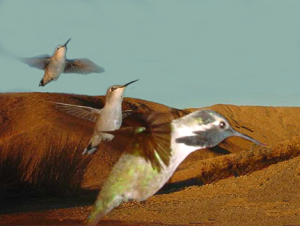
1 March Thursday Anchored at Malta
Seas were so rough we didn't get out of port. I have been fighting for a rocket hop using the 5" HVARs instead of the smaller 2" SCAR training rockets. So will see if it's worth my effort. Nobody seems to know anything or seem to care.
2 March Friday Pulled up Anchor Enroute to Palermo
Our detachment flew 8 sorties today. A five plane rocket flights this morning with the 5 inch HVARs was launched firing on a smoke light aft of the carrier. Maybe we'll now start getting some good ordnance hops. I flew the rocket hop in 4Q #33, a 3 hour deal. OK. A F9F jet landed with one wheel up and he made a fine landing into the Davis barrier (net) with minimal damage nobody hurt.
Tomorrow we hit Palermo for a couple of days.
3 March Sat Pulled into Palermo
Dropped anchor at 0800. Saw 4 movies a record for me. Made the evening pass quickly.
Burke and Miller went to an evening cocktail party given by the American Consulate.
4 March Sun Anchored Palermo
Dick and I went into town tonight to see what there was. Not much was the conclusion. Looks a lot like Rome and Naples but has no nice bars except for the one at the Grand Hotel. But even so Napoli is far superior.
This noon something different happened but not so funny to one of the men. Edgar was flying his wired u-control model on the flight deck when the wire broke and the little plane went through a F9F's tail! Was VF-61's skipper's F9!
Bill must be wondering "what next"!?
5 March Mon Anchored Palermo Shove off tomorrow back to Malta.
6 March Tueday Enroute to Malta
What's next? It was bad – today one of the AJs crashed just aft of the carrier about a mile astern. It was on fire, smoking and just before hitting the water its tail blew off. There were no survivors. Then a one of the F4Us was forced to make an emergency wheels up, flaps up landing causing strike (major) damage going into the fence. Fortunately no injuries. Good job of landing with no hydraulics.
Tonight we watched the night recovery from vulture's gulch. Couldn't figure out why a VC-4 Banjo couldn't taxi forward after what looked like a normal night landing. Pilot kept giving it full power! It wouldn't move! Couldn't move, as both landing gear struts were driven through the wings and the tires were flat! Sort of a hard landing. Otherwise and OK pass.
We flew two day tow hops and two night sorties. No problem.
7 March Wed Enroute Malta
No flights today. Bad weather everything tied down. At about 2000 we changed course toward Rome when a Navy PB4Y2 Privateer patrol bomber was reported down off western Italy.
8 March Thursday North of Sicily.
Launched 29 planes for search. Our detachment launched 3 ADs at 0600.
Searched for four hours. No luck! Late afternoon two rafts we spotted with six survivors. Eight crewmen are still missing.
The weather was bad most of the morning but improved in the afternoon. The deck is pitching and rolling.
Tonight we are headed toward Rome. Tomorrow morning an early search hop will again be launched.
9 March Friday Search Area off Rome
Continued search for remaining survivors of downed PB4Y2 off Rome. A yellow object was sighted several times by five F4U pilots but because of the heavy seas keeping track of it was impossible.
We launched 2 aircraft. I flew a 4N but no joy finding anything.
Tonight at 2315 we are headed back to Malta to off load the two AJs and pick up the planes and crews left on the beach.
10 March Sat. Heading back to Malta.
Flew morning bombing flight SS 34 4.0 hours.
Anchored off Malta in afternoon. Went ashore for supper at Phoencia Hotel; very good meal. Visited the "Gut". Returned to ship at 1130.
Saw Rugby match at Halfar. The game makes our football look like a child’s game. Had an ambulance making runs to their infirmary.
11 Mar Sunday Off Malta
Pulled out of Malta in afternoon. Regular Sunday at sea. No flight ops today.
12 Mar Monday Off Malta
Flew 8 sorties today. Everyone got one hop. That's different. I had a bombing and rocket mission in SS # 3 of 1.9 hrs.
More days like today and we'd be red hot. Towing tomorrow. Night flying cancelled tonight. No reason given.
13 Mar Tuesday Operating off Malta
Flew 10 sorties today. Flew two tow flights in morning and afternoon.
Morning flight the ship screwed up. This afternoon both Geist and I had tow gear troubles in Sugar Sugar 33 and 34.
Upon landing much explaining was necessary to the Admiral no less.
Both our crewman had trouble and all two miles of cable was lost in one plane. Incomplete mission, most embarrassing. My ass is grass.
14 Mar Wed Operating enroute to Gulf of San Juan Fran.
No day flights. We provisioned all day. Tonight 3 planes from the VC night teams flew. It was a beautiful night.
Tomorrow we're supposed to get a replacement AD from the USS Wright before they get relieved.
My ordnance gang worked long and hard today getting the tow planes rerigged for tomorrow's 15,000 foot tow hops. If anything goes wrong this time it's my ass again!
15 Mar Thurs Heading for Cannes France
Launched in SS 33 one of our tow planes but bad weather made it a 3.4 hour orbit of the fleet Useless but everyone tried to get it done. Everyone awaiting tomorrow and France.
16 Mar Friday Gulf Juan AM, Anchored Cannes France We entered port at 0800.
Just before anchoring Bill Alexander flew replacement AD 4N SS# 14 over from the Wright. Fine looking plane.
Liberty commenced about 1800 and liberty section one, Burke, Geist and FCB hit the beach. My first impression was as could be expected; what nice looking ladies!
We met up with Cook and Ilgen at Lalu's a legendary bar. Good bar. We ate a fine meal. By 2000 both Hos and Ilgen had had it. We made the rounds from there. The French Rivera is everything a sailor could ask for. Two more days of liberty thank goodness.
17 Mar Sat Tied up in Cannes
Captain's inspection this morning. As usual it was a long long time at attention. It was bright. No sun glasses permitted. Duty tomorrow.
18 Mar Sun Cannes Duty no liberty
19 Mar Mon Cannes Liberty
Geist and I left the ship at 0830 and visited some French folks who own a small hotel. Very friendly and recommended by Clint Mundt. (Clint was a pilot in our squadron who was killed in an accident in the 60s off
the Italian coast). Afterwards we took a bus up the hills to Grasse visiting a perfume factory.
It was most interesting seeing how the many flowers are needed to get so small an amount of pure perfume. We made some purchases then ate a fine meal in the village restaurant. No one understood us but we went away full and happy.
We took a bus to Nice.
In Nice shopped and people watched until about 6 PM. Went into the famous casino where we later ate. I gambled and won 3500 francs playing roulette. Met a French girl who was too eager to show us the games with our money. Saw the Aga Khan who looked like he weighed over 300 pounds. He had two very attractive young honeys walking him into a private gambling room. Back to the ship at 3 AM.
20 March Tuesday Cannes Provisioning
No liberty for anyone today. Tomorrow we're suppose to get some fresh diary products; perhaps some fresh eggs and milk at breakfast! (Powered eggs were next to starvation rations in those days!)
Supposed to go out and operate tomorrow and return to port about 1600.
21 March Wednesday Cannes
Upped anchor and operated off Cannes. We flew 6 planes. The French landed 8 F6F Hellcats this morning. Rather hairy looking coming aboard. Probably been a long time since they've done any carrier work.
The Communists have caused Nice to go out of bounds today. Liberty cancelled for men effective immediately. Expect trouble is brewing. May Day's coming.
22 March Thursday Cannes
Same as yesterday; I flew two hops today in SS 5 for 5.8 hours. The group took 65 minutes to get 65 planes back aboard in the morning! I took two wave offs. Everyone is rough. France is rough.
Geist and I went ashore again. Won a few more francs spinning the wheel.
23 Mar Friday Cannes
Operated as usual except no afternoon flights for ship's refueling.
Good Friday today. Lent has passed swiftly. In fact the whole cruise has been quick. The Saipan (CVL-48) has joined us replacing the Wright. Bill Bland is our VC-33 detachment's team leader.
24 Mar Sat Cannes Duty
25 Mar Easter Sunday Cannes
Mass and holy communion. Geist and self went aboard the luxury liner the USS Independence anchored a few miles from us. Got some good American beer. What a ship!
Went into the Casino in Cannes and dropped a few francs.
26 Mar Monday Cannes
Burke had my name printed on both sides of SS # 33. Now my plane.
27 Mar Tuesday Cannes No remarks.
28 Mar Wednesday At sea west of France
Upped anchor in the morning. Flew 4 planes in afternoon.
29 March Thursday Off northern Italy
Four of us flew an Anti Sub Patrol today. It was 3.4 hours in SS 13 for me. Meints and Geist had three radar sub contacts while Jay and I had no business. (On my second Med cruise aboard CV-40 the Tarawa in 1953, I got credit for sighting and sinking three "enemy subs" during a NATO exercise).
Night flying was cancelled due to bad weather in the afternoon. It was beautiful tonight. Weather guessing is tough everywhere!
30 March Friday Off Italian Coast
Flew 7 sorties today. All seven planes. Both tow planes pulled the sleeves for the entire fleet. Everything went OK. I flew my machine #33 3.0 hours.
Hirth was the tow reel operator.
1 April Sunday at Sea No ops
2 April Monday At Sea
Had a 5 plane simulated strike at 15,000 feet. We joined VA-25's Able Dog formation. Most work I’ve had flying formation in long time since flying Turkeys (TBMs). Flew SS 33 for 2.3 hours.
A Marine F4U's engine quit at 16,000 and the pilot rode it down making a water landing next to a freighter. The English ship kept going until a few buzz jobs by his buddies got their undivided attention. The ship finally picked him up, uninjured.
Night flying cancelled again. I haven't flown at night since 23rd Feb. The next time should be a thriller.
3 April Tuesday Enroute Liverno Italy
We flew another 5 plane hop along with VA-25 at 15,000 feet. They had another hairy time of it as we did yesterday I was told.
Last night around midnight we passed very near the island of Stromboli, north of Sicily. Its active volcano was putting on quite a show for us. It was pitch black, a clear night and a bright red, running down the mountain's slope in jagged paths. The volcano would erupt sending red clouds high. Everyone not on duty made it up to the flight deck once in a lifetime show. What a rare spectacle! We watched until it was out of sight. Rumor number umpty umpt is we will arrive in New York 11 May. Everyone claims the closer we get to home the bigger the story.
Today I got to fly in the ship's rescue helicopter piloted my Pre-Flight classmate Willy Wirt. (He later was to head up the Navy's flight test department for choppers at Patuxent). We hovered back of the FDR on the starboard side a couple of hundred feet off the water during the take off and landings ... I got some good pictures.
4 April Wed Liverno Italy
Arrived at 0800 this morning and anchored. Port not impressive after Nice and Naples. Went ashore on standby liberty at 2330. Not impressed.
5 April Thurs Liverno (Leghorne) Mail
6 April Friday Liverno Liberty.
A bartender spoke very good English and was most interesting. Said he was a POW from the North African campaign. Learned my name was Bonansinga and said that isn't Italian! Told him my grandfather was full- blooded Italian one of 12 boys born in Milan. He said my name was probably changed and should be spelled, Bonansigna. My son, Frank D. changed his name to the new one because of this story. Later learned the original name is correct as verified by several distant members of the Milan Bonansingas. Biff still keeps the -signa spelling.)
7 April Sat Liverno
8 April Sun Liverno
9 April Mon Liverno
10 April Tues Departed Leghorne
Flew 6 planes. Had Instruments and Intercept flight in my plane AD 4Q SS #33 1.8 hours.
Night flying cancelled – as usual. We were suited up ready to go. No reason given. We don't think they like night flying either!
Journal
Med Cruise #2
11 April Wed Med south of Sicily enroute to Taranto
Flew 6 planes today .Two tow sorties and 4 4Ns on a strafing, bombing and rocket mission. I got to fly it in SS#3 1.7 hours was a good one! Tonight the mechs discovered metal filings in the oil sump on my machine #33. Needs an engine change as they figure it will be down for a month! Fortunately they found it or someone might have got wet or worse.
Back to 8 pilots and 5 planes.
12 April Thursday Port
Arrived Taranto at 0800 anchored in port. Liberty 1630. Burke and I went ashore. Not bad. Not much doing either. But we fell into a beautiful trap! Bill and I were offered a real good money exchange from a young street boy. We agreed and gave the kid a twenty as he is counting out our lire when he suddenly looks up and yells, "policia and hands us our 20s and runs! Unfortunately the 20 is a 1.
13 April Friday Taranto
Ship operated today, putting on an air demonstration this afternoon for visiting Italians. Everything went fine. Received news Miller, Holden, Keller, and I are to make LTjg in June. Two years as Ensigns. The men with the help of the ship's mechs are working 24 hours a day getting # 33 back in flying condition. Hopefully before the ship's operational readiness inspection next Tuesday. At present 16 sorties are scheduled for us.
Got my wings two years ago today.
14 April Sat Departed Taranto for Napoli
I Flew this afternoon and tonight. Operated with Saipan and Coral Sea who just arrived. Also many destroyer and cruisers.
Had no radio tonight. Got a wave off then got aboard ok. First night flight in long time. The moon helped.
Looks like I'll go back to states on a destroyer for training.
15 April Sunday At sea.
Holiday routine. No flight ops – tomorrow and Tuesday should be big, busy days/nights. But will we have all the planes up?
16 April Monday At sea
Flew 3 planes .OK
17 April Tuesday At sea
Operational Readiness Inspection of the Air Group.
First hop off at 0530 from our det. In all we flew eleven day sorties and 4 night. The hops included rockets, bombing, air to air gunnery, search, ASP and night intercepts. The night illumination hop by Hemler was very good. Results will be published later. We missed only one sortie and the men deserve high praise for the work done to make the availability what it was.
18 April Wed Off Sicily enroute Napoli
Meints, Keller, Geist and I flew 4 Skyraiders to a small dirt strip outside of Tananto. We took some government officials ashore. The hop took little over two hours and was most enjoyable. We flew across the northern edge of Sicily passing Mount Etna and by the Straits of Messina; then passing over the boot's toe direct into Taranto. The Italian pilots were very friendly. Had fish, cheese, bread and wine for lunch. They were flying the US Navy's old SB2C Curtis Hell-divers! Pieces of shit!
We departed there at 1245 and landed back aboard at 1545 after our short liberty on official business .5.2 hrs XC in SS 13.
19 April Thursday Enter Napoli Harbor
20 April Friday Liberty Naples
21 April Sat Naples
22 April Sunday Liberty Naples
23 April Monday Departed Naples
Flew 5 planes to Taranto to pick up the observers and crewmen left on the 18th .
24 April Tuesday At Sea
Anchored back at Leghore 0630 to take on the aircraft duds from Coral Sea. Departed at 0900. We flew 3 tow hops and a two plane intercept hop. I flew #13 on an intercept sortie 2.2 hours.
I get to go to Paris with Burke as no one else wants to go! Tomorrow Cannes.
25 April Wednesday Anchored at Cannes France.
26 April Thursday
Burke and I departed for Paris via the train early this morning to arrive at 2145 tonight. After checking in at the deux Des Mondes Hotel we head for the closest night club. It had bare breasted women walking around on
the bars Accepted as normal in Paris. Was done in a very refined manner. I like Paris.
27 April Friday Paris
Visited Notre Dame Cathedral. Went to the top, saw the gargoyles. everything.
Visited night clubs, saw more bare-top bar walkers. I still like Paris.
28 April Sat
Visited palace at Versailles. Saw Napoleon's tomb. Did some shopping. Night clubbing.
29 April Sun.
Church at St. Pierre De Chalot. Visited the Eiffel Tower. Had lunch up there. Some view. More night clubbing; went to Follies floor show! Nothing like this at home. Viva La France!
30 April Monday
Departed Paris on train at 0745 to arrive in Cannes at 2215. Fine trip. (Late note) I put my middle of the month U. S. government pay check on top of a dresser in the room and proceeded to leave it there. Eventually got another one issued after a long time. It was about a hundred and twenty five bucks. We didn't make much in ‘51 as Ensigns even with flight pay.
1 May Tuesday
May Day – Communists celebration in Cannes. Geist and I went ashore late .The French Commies are very anti US this day. Heard all kinds of pointed remarks about Truman at bar. The folks were looking for trouble. We leave tomorrow. Probably good.
2 May Wednesday Departed Cannes for Gibraltar. Flew 6 planes in afternoon and 4 planes at night. I flew both hops. Tonight was one of the darkest we've seen in a long time. But all of us got aboard on the first pass thanks to LSO Bill Ecker and some good luck. Just under two minutes for the four of us to land. Still feel sort of rusty from gay Paree and no flying.
One of the Siapan's F4U 5Ns from VC-4 wasn't as lucky and hit the island on the Saipan. We saw its fire but don't know what happened, damage etc. Flew #33 both flights 5.3 hours total for the day ...
3 May Thursday
Detachment flew at night; all did good OKs.
4 May Friday Med enroute to Gib.
Flew an ASP mission with Miller. We landed on the Siapan, ate and shot the bull with Bill Bland's pilots, Hill, Janiec, Raskob, Voigt and Kelsey.
Landed back aboard the FDR after another ASP mission in SS 7 after 5.2 hours and my last flight and landing on this cruise.
VC-4 returned from being off-loaded-several weeks ago and the Coral Sea took our 4Q SS 33 and AD-4N SS 13 leaving us 3 ADs for the Atlantic crossing Tomorrow GIB.
5 and 6 May Anchored in Gibraltar.
7th Miller and I transfer to USS Greene DD 711 a Destroyer for training as Junior Officer of the Day watches back to Norfolk. Went ashore in Gibraltar. It's supposed to give us the needed qualifications to make Regular Navy if offered again.
8 May Tuesday
DD-711 Gibraltar Got Underway at about 0745 this morning. Tour of gunnery area, 5 inch gun mounts, 40 mm guns and torpedo magazines. Saw depth charges, hedge hogs and fire control areas.
Seas became rough in late afternoon. Stood 2000 to 0000 JOOD watch. Seas now moderate to rough. Holding station (position) 49 degrees at 4,000 yards. Made two course changes.
9 May Wednesday
DD 711 Atlantic Ocean Seas still bad. Ship is rolling thirty degrees at times. Engineering space inspection and indoctrination. AA firing at a drone in the afternoon. Evening seas smoothed out.
10 May Thursday
DD-711 Atlantic Ocean. Seas fairly calm with a slight roll and pitching motion.
Communications lecture in the AM. Refueling in the afternoon. Good chow aboard the Greene. Always heard chow is better on cans and it's true. With the weather and ride they give, I know why.
11 May Friday DD-711 Mid Atlantic.
Stood 4 to 8 JOOD watch. Held station on the guide ship. Had a Z-3-G target acquisition drill in the morning against drones.
Stood a 2000 to 2400 watch.
12 May Saturday DD-711 Mid Atlantic.
We are supposed to arrive Norfolk one day earlier, now the 17th of May at 2PM. ASW check out by Ed Miller. Interesting and good looking gear.
Seas became heavy about 1500 and by 1800 my usually huge appetite was gone. Nobody ate anything but sandwiches. Wardroom dinning is impossible. Everything would slide off the table. Trying to sleep requires being strapped into the bunk! This is some kind of tough living when it's like this. No wonder the cans get so much ice cream!
Stood second dog watch 1800 to 2000. Plenty rough Don't expect much shut eye tonight. Strapped in tight.
13 May Sunday…
DD-711 on the Atlantic. Seas smoothed out in the morning. By this afternoon the seas were as calm as glass! The oceans can be confusing and not to be trusted when on a can. Stood a 1600 to 1800 dog watch.
14 May Monday
DD-711 Atlantic. Rough seas again! In fact heavy seas. It's the closest I've come to getting sick. I have never been air sick.
Stood my 1200-1600 watch and looked at the sky, the clouds, the horizon, just anything to get my inner ear to calm down. It worked. Fixed me up ok; felt better. Still no one is eating and it's strap yourself into the sack jack.
I listen to my records.
Seas ok by 2300 and finally good enough for sleeping.
15 May Tuesday
DD-711 700 Miles to USA. Beautiful day 0800 to 1200 watch. Only the FDR and six DDs are left of the force.
Everyone is in fine spirits and who wouldn't be? We now have a constant flow of American radio music and baseball scores the news. It's great.
16 May Wednesday
DD-711 A Little closer. Good Weather. Stood 0400 to 0800 watch. The FDR launched all her planes but two returned with emergencies! Wonder who!
There are 4 ADs parked on the fantail. Tomorrow is the day.
17 May Thursday
DD-711 USS Greene & Our Last Day. Stood the 0000-0400 JOOD watch. We were 97 miles from Cape Henry. Will be in port by 2 PM ..
Jug and I were met by a squadron AC and flown to Atlantic City.
18 May Friday
Atlantic City NJ. Requalifying in GCA. No more DD crossings, please!
Aircraft flown by Frank C. Bonansinga
Manufacturer & AC Data Date & Place 1st flown Total Hrs
1 Piper J-3 Cub SE prop fixed gear 65 hp 5 Oct 46 NO Lakefront 98
2 Aeronca Chief SEP fg 65 hp 28 Sept 47 Crestview FL 2
3 N. American SNJ Texan SE 650 hp (Navy) 14 Feb 48 NAS Penscola 251
4 ChanceVought F4U Corsair SE 2000 hp 28 Sept 48 NAS Jax FL 165
5 Grumman TBM Avenger SE 1800 hp 30 Jun 49 NAS Norflk VA 515
6 Grumman F6F Hellcat SEP 2000 hp 11 May 50 NAS " 160
7 Grumman F8F BearCat SEP 2000 hp 22 May 50 NAS " 66
8 Douglas AD Skyraider SEP 2200 hp 6 July 50 NAS AC NJ 1,777
9 Douglas F3D Skynight Twin Jet 13 July 53 NAS “ 757
10 Beech SNB Twin Eng Prop 550 hp 10 Jun 54 NAS “ 1,943
11 Beech A-35 Bonanza SEP 175 hp (Raytheon) 21 Nov 55 Bedford MA 257
12 Cessna 310 Twin Cessna TEP 1 Mar 56 Hanscom Fld 47
13 Beech B-50 Twin Bonanza TEP 4 Mar 56 " 63
14 McDonnell F3H Demon Mach 1+ Jet 14 Apr 56 " 160
15 Covair 131B MultiEng 2000 hp 11 May 56 " 10
16 Douglas B-26 Invader/Onmark 2000 hp 19 July 56 " 655
17 N. American F-86F Sabre subsonic Jet 8 Oct 56 " 131
18 Piper PA-21 Twin Appache TEP 2 Aug 57 NAS S. Wymouth 32
19 Douglas F4D Skyray Delta wing Jet 24 Oct 57 " 757
20 McDonnell F4H Phantom II Mach 2 Jet 9 Nov 59 Bedford MA 341
21 Cessna 172 SEP fixed gear 7 Jun 61 Hanscom FLD 4
22 NA 500 Aero Commander Twin Eng 28 Feb 63 " 2
23 Vought F8U Crusader Mach one+ Jet 18 Nov 63 " 2
24 Piper TriPacer SEP fixed gear 8 Mar 65 LasCruses NM 21
25 Volpar VTB 18 Turo Prop (Air America) 25 Jun 66 Taiwan 5,785
26 Cessna 150 Single Engine Prop (Civilian) 20 Mar 73 Manassas VA 1
27 Piper PA-31 Navajo Twin Eng Prop 24 July 74 ILpgo SS 4
28 Beech Sierra SEP 13 Sept 74 Guatemala City 1
29 Beech A-36 T Tail Bonanza SEP 15 Nov 74 Ilogo San Sal 3
30 Piper PA-34 Seneca Twin Eng Prop 5 Dec 74 " 10
31 Piper PA-23 Aztec TEP 19 Aug 75 " 38
32 Piper PA-30 Comanche TEP 3 Oct 75 " 22
33 Rockwell AC Twin TurboProp 69C 5 Oct 76 Fresno CA 68
34 Lear 24 Twin Pax Jet 14 Mar 77 John Wayne CA 1
35 Cessna 185 SEP fixed gear 11 Apr 77 Wichita KS 9
36 Mooney 21 Single Engine Prop 21 Apr 77 Manassas VA 3
37 Cessna 170 SEP fixed gear 30 Apr 77 Hampton NH 1
38 Beech C-55 Baron Twin Eng Prop 30 July 77 Love Fld DaL 19
39 Piper 140 Cherokee SEP 27 Apr 78 Moisant NO LA 1
40 Cessna 172 Seaplane SE twin floats 30 Aug 78 Winterhaven FL 4
41 Swearingen Merlin IIIA Twin TurboProp 24 Oct 79 Lk Front NO 149
42 Grumman AALB SEP fixed gear 22 July 82 Bermuda Dunes 1
43 Beech 66-88 Queen Air Twin Eng 17 Nov 84 Thermal CA 9
44 Piper PA-44 Seminole Twin Eng 12 Jan 85 Santa Barbara 29
Flight Hour Breakdown
Prop 6,336 US Navy 1948-55 3,510 Instrument 1,846
Jet 1,846 RDT&E Raytheon 55-65 2,654 Night 1,897
Turbo Prop 6,002 Air America 65-73 6,360
Total Pilot Hrs 14,184 Civilian 1,660
Landings 8,742 Carrier landings 317 on 13 Carriers
Raytheon
Released from active duty after almost 10 years of service, I had no job awaiting me. My wife Joyce was from the Boston area so I ended up looking for job with Raytheon one of largest employers in New England. I had learned to run a lathe, internal cylindrical grinder, drill press, weld all the machine shop stuff as a kid working in the summers in defense plants. Figured I could get a job until I could get back with American as a copilot or perhaps Pan Am.
Went over to the headquarters in Newton and was awaiting an interview when the gentleman to interview me phone rang. The man on the other end calling was the chief pilot for Raytheon and he was looking for a pilot.
Sometimes things are hard to explain. This is one for me. I was hired as an engineering pilot for Raytheon.
Fortunately with the night, radar, instrument and some test work background, it landed me a job with Raytheon.
The Missile and Space Division had a flight test facility and transportation department at Hanscom Field.
Most of the test missions were flown out of Hanscom Field Bedford, Mass. I also flew bailed/loaned aircraft (F3D Skyknight, F3H Demon and F4H Phantom IIs at PT. Mugu and Patrick AFB while working on the Pacific, White Sands and Atlantic Missile ranges). And a few missions flown at China Lake and Oceana and Patuxent River.
George Bottjer my first boss, was a Navy Cross carrier TBD pilot from the battle of the Coral Sea. I also later learned he had flown down to Atlantic City to check up on me. It is a small world.
In August of 64, the SETP, Society of Experimental Test Pilots made me a full member for my first flight test work flying mainly Navy aircraft. My work at Raytheon was like shore duty except I was a civilian.
The Sugar Bowl Show
Right after joining the V-5 program, the Navy sent me about a mile or so away from home to college. “Join the Navy and see the world” slogan did not work here.
We had just started the first semester of V-5 at Tulane University in New Orleans. The “Green Wave” was playing a very good Notre Dame football team and Tulane was expected to get crushed. All the V-5 and V-12 students were in uniform, wearing bell bottom blues in the stands, at the Sugar Bowl on Tulane’s campus.
The first half had just ended with Tulane unbelievably leading Notre Dame 7 to Zip! An upset?!
Suddenly everyone was stunned by the roaring sound and sight of a squadron of Navy F4U Corsairs coming in low, just over the goal post from the open end of the stadium.
The fighter plane leader did a roll and each of the following Corsairs likewise rolled the slick bent wing birds past the roaring crowd.
Everybody went nuts, clapping, yelling and waving, as the World War II Navy pilots, their planes, put on a show never to be forgotten. (The CAA forerunner of the FAA didn’t worry about things like this in 1945, and after us winning a war.)
My Dad was home listening to Bill Stern the famous sports announcer, doing the game on radio.
When the squadron of fighters came around for the final pass by the thousands of cheering fans, Stern described it as; “And here come the Navy fighters again, really low and oh, ah, they’re dropping, STREAMERS”!!
Roll upon roll of toilet paper was floating down, covering the field. As each Corsair twisted making a barrel roll, each pilot threw out a roll of toilet paper unrolling on target, then pulling up to clear the far end of the stands.
Oh what a sight! Everyone was happy, laughing, shouting and yelling, Yeay Navy! Man were we proud V-5ers!
The final score, Notre Dame 30 something and Tulane 7. Was a surprising first half but a much better half time show.
letter to Lou Ives
9 May 89
Enjoyed reunion and meeting you along with others. Just sorry none of my class, or squadron-mates who were FMs showed up. Here are a couple of shorts about our days in midshipmen days that you might like (or dislike) to add to the tales. Or perhaps another has already told. Would like to know regardless …
Midshipmen Jets Basketball Team 1947- 48 Pensacola FMA
In the fall of 1947 after moving from Ottumwa, IO. to Pensacola FL and after graduating from 20 weeks of P-F many of us midshipmen were awaiting instructors. We graduated from pre-flight on 1 November 1947 but were pooled with little to do except play hearts, get free rides in the back of SNJs, PBYs, and SNB type aircraft out of Mainside. With all this time on our hands a couple of us decided to form a Midshipmen basketball team and we approached the Marine Officer group who rode herd on us even after we got out of P-F.
Unfortunately or otherwise they had no desire to sponsor us. We formed a group called the JETS so we sponsored (paid for) ourselves.
The jets were not tall not short just like all of us FM fairly average sized young guys but oh how we played to make up for sizes! We beat them all the long and the short and the tall. We won from the Basic officers, Pilot officers, the best the Chiefs had to offer, the best the EMs could throw at us. And some of these teams had good experienced certainly older players. We averaged about 19 years as most of us joined at age 17 during that era.
The Jets won the whole thing. We were presented three pretty nice trophies and we took turns keeping the prized trophies in our rooms in the wooden barracks we were assigned to. We ended up being asked to scrimmage the Base team the Goslings I think they were called. We lost by a point!
Within a couple of days the Jarheads confiscated the three trophies and put them in the Marine office.
Really didn’t make much difference as we all got our instructors about 1 April 48 and the basketball took second really low second place to getting assigned an instructor. My instructor was LT “Red” Halligan a hell of a nice guy and you guessed it – a marine.
The team consisted of the following:
William “Bud” Barry went to VC-32 Norfolk then Airline pilot of AA.
Frank Bonansinga VC-33 Norfolk + AC 5 years (two tours, Mid to LT USNR)
William “Bill” Clark no info on Bill
William “Bill” Dobson got (was married) Mandeville LA Sheriff.
Harry Dodd no info
Norman DeBay no info
Stanley VanLiere F4U pilot from Holland, Michigan killed in F4U accident Jacksonville FL 1949 after he received his wings.
Jerry Walterskirchen VC-TBM pilot Norfolk got out; from Rockies area, probably Col.
FMs Volunteer High Altitude Exercise and Rapid climb to 20K group.
November-December 1947. Volunteers from Pre-flight classes 12 and 13-47. During the fall 1947 pool of graduated Midshipmen who were waiting on instructors (a five month wait for many of us low lifes), there were “opportunities” that looked like offers you couldn’t resist but should have. This beauty was a little pressure chamber deal that Commander Schidmital (spelling is questionable) the then head of aviation medicine at Pensacola dreamed up. It was patterned after a ‘39 movie flick perhaps; anyway Errol Flynn and Fred MacMurray did about the same thing in Dive Bomber in the thirties.
Five of us volunteered to go “up” twice a day at 8 am and 12 noon depressurizing to an altitude of 20,000 feet in a climb time of two minutes. We then exercised every 5 minutes for 30 seconds and did this 5 or 6 times. The trip up and down taking 40 minutes. We were supposed to show the Flight Surgeons and aviation folks just what would happen to future “jet” pilots who would climb to 20,000 in two minutes, fly their machine, and return. We were supposed to report anything like anything that happened. We made 42 trips over a 21-day period and the worst thing that happened is some foul smelling gas and an eye lash in someone’s eye, caused some eye blurring, and one case of the bends.
P. S. We never did get the 72-hour pass they promised. That’s why I never trusted a doctor again, and four other guys thought the same.
The group consisted of Art Barie [12-47] VC-33 TBM then AD drivers at Atlantic City. A Skipper of squadron Ocean in 60s, then lost contact.
Frank Bonansinga, like Art [VC-33] later Raytheon test and Air America pilot [Pre-Flight 12-47], Member of The Society of Experimental Test Pilots for work done on early (1959) F4HIFCS and Sparrow III as civilian.
Frank Specht lost contact 13-47PF
Hollander " " 13-47PF
Cosgriff " " 13-47PF
letter to Pat Francis
28 August 1994
A picture of three Flying Midshipmen who were assigned to VC-33 at Norfolk in ‘49 flying TBMs and then called back in to fly VC-33s AD-4Ns at Atlantic City in June 50. We hadn't been together in over 40 years and had a great time at Art's last January.
Art and I were in 12-47 and I think Al Doles was in 17-47 but am guessing.
The former V-5 Midshipmen served together in VC-33 first flying TBMs at Norfolk then AD4Ns at Atlantic City.
Wives Pogo, Sharon and Dona tried to maintain some semblance of truth during hours of incredible flying fables; but failed.
“The picture could be titled ‘Reuniting after over 40 years (L-R) Art Barie, Frank Bonansinga both 12-47 and Al Doles (17-47) pictured at Art's retreat in Palm Desert, California.’”
The Blue Goose and the Steel Tiger
Air America’s B26 Night Drop Project-By Frank Bonansinga.
A dark blue long nosed twin engine airplane showed up at the AA ramp in Udorn, Thailand in May of 1967. It was to make night drops to supply infiltrated indigenous troops in unfriendly territory. These surveillance teams operated between the Mu Gia Pass to Tchepone in east central Laos. This area with its jagged hills, called karsts, had a network of roads from North Vietnam snaking in and out of the jungle cover toward South Vietnam. The network of roads was referred to as the Ho Chi Minh Trail and the area was code named "Steel Tiger." The sleek machine was a B26.affectionately referred to as the "Blivit" which implied something stuffed full of more then it could hold. This was true, as it had everything from A to Z when it
came to electronic equipment and then some!
The Blue Goose was considerably different from the WW II Douglas A26 Invader; a medium bomber whose designation was changed to B26 in the 1950s. This hybrid B26, arrived with many of the modifications taken from the OnMark Company's corporate Marketeer and a few from the OnMark USAF B26K attack bomber also known as Nimrods when flown at Nakhon Phanom in eastern Thailand.
The similar modifications consisted of wing tip tanks, copilot instruments and controls, and enlarged rudder for better control, oversized anti-skid brakes and an air stair door on the starboard side. The engines had reversible props and with water injection, gave each P&W engine 2500 hp on take off. Also our Blue Goose had the bomb bay doors removed and the addition of a large couch with several seats as in the corporate Marketeer modification.
The paramount changes featured in this B26 were Terrain Following Radar; precise navigational gear and a cargo drop ramp. These additions enabled 1159811 to deliver supplies at night, at low level and in most any kind of weather. The TFR was new at that time. In fact, the only aircraft to have it was the new USAF F111, an all weather twin jet fighter bomber not yet deployed in SEA. Installed in the B26 nose, this unique radar enabled it to fly low at night over any terrain getting to the drop area and away from it as quickly as possible. The auto pilot could be coupled to the TFR and the navigational equipment was checked before and after each flight with exceptionally accurate results.
The other major feature in AA's B26 was its cargo drop ramp, similar to that in the C123 and the Caribou aircraft, but much smaller. A pallet of approximately 500 pounds of supplies was pushed out of the 26's cargo ramp by the Air Freight Specialist (AFS) or as commonly called, the kicker.
The B26's main wing spar still ran through the fuselage causing the 3 man cockpit crew to crawl under the large metal main spar to enter the cockpit from the cabin. This made hasty egress via the cabin impossible. Also, the cockpit hatch couldn't be used for bailing out, without the high probability of hitting the wing root and/or the tail section. Thus, parachutes were sat on and seldom hooked up, except by the kicker.
Navigational equipment besides the radar and computer was a military type Tacan, an ADF and the VOR/ILS nav/landing aid. Communications gear was UHF, VHF and HF radios and an IFF encoder, a radar altimeter and one black box in the center console, its use never explained and never used.
The navigator was stationed behind the pilot with his table and chair where he operated the navigational equipment and radar. Besides this important job, he helped spot the drop zone (DZ) lights on final run in to the drop site.
The crews flying in the 26, as best remembered, were: Chief Pilot Jim Rhyne, Pilots, Berl King, Gene Hughes and Bonansinga. Copilots, Walt Darran, Bill Reedy, Ed Dudeck, Dave Krebs, Bill Harvey and Terry Luther. Navigators, Roger "Mac" McKeon, Richard Andrews, Raymond Feind and (?) Richey. Kickers, Billy Hester, Miles Lechtman, Mick Swift, Bill Buzard, Robby Roberts and Cliff Hamilton.
Pilot Don Gearke along with electronic technician Paul Byrne and Mechanic Leonard Billotee, all from Intermountain in Arizona, gave us a short ground school on the aircraft and its electronic equipment prior to check out in the B26.
After about 7 hours and a similar number of landings (from my log book) AA's check captain Albert "Rocky" Meier gave King, Hughey and Bonansinga, line checks with Don Gearke observing the rides. We then flew together making practice day drops at the Thai Border Police camp outside Udorn followed by several night drop missions to road watch teams, training in Laos.
On one such night training flight northeast of Savannakhet (L-39), "Practice" tracers were coming our way. Berl and I stopped dropping and returned to Udorn. That night, at the Club Rendezvous, we learned the troops where we had dropped had to expel attacking unfriendlies. Only then could they call it a night after their "training" exercise.
The typical mission was to supply the surveillance teams with food, hard rice (ammo) and whatever they required. A road watch team, "Stag & Quail", were two code names remembered, would radio in their needs, giving a drop zone location and receive an agreed upon drop time and signal; usually it was a T or L made with flash lights. The DZ signal was turned on just prior to the expected drop time or when the 26 was
heard. There was no communications between the infil team and the Blue Goose, so if no signal was seen, it was a no drop. And only one pass to the DZ coordinates was made. The aircraft was normally towed to the Udorn customer's warehouse, referred to as the AB-1 ramp for loading and briefing. The kicker supervised the loading while the navigator and pilots figured the flight plan, usually departing Udorn after dark. The flight called for the plane to descend to a low altitude entering the Steel Tiger after crossing the Mekong River into Laos.
We'd hit an initial point (IP) at 7 or so miles from the DZ, slow to approximately 140 knots and the kicker lowered the ramp. After the DZ lights were spotted and the load dropped, we headed back to Udorn or sometimes to Savannakhet to reload for a different DZ.
AA had excellent, if not the best maintenance in SEA and this was particularly true at Udorn. We were most fortunate to have Stan Wilson and crew at AA's Savannakhet base. They furnished the 26 with excellent service and maintenance, besides keeping the Volpars going on their "all niters.
Nonetheless, problems occurred as in all machines. Several in flight engine shut downs and an electrical fire are well remembered. Another time, a load got off the tracks and the AFS somehow managed to kick it out and kept from going with it. Then once, departing from the customer's warehouse at Udorn, a prop got damaged when a wheel dropped into an unseen pot hole one very rainy night. Fortunately, soon thereafter, the entire customer ramp and taxi way was repaved.
The B26 was similar to dropping in AA's other aircraft except for two problems. First, it was too fast, with a minimum drop speed of 140 knots (163 mph) compared to 122 knots in a lighter A26 Invader. This minimum safe control speed, if an engine failed (Vmc), was higher than most of our other drop machines and cut down the maneuvering or line up time once the DZ lights were spotted.
The other major problem was seeing out to drop. The pilot's forward vision was hindered by the Blue Goose’s nose. Once the DZ was spotted, a slightly curved approach in a left turn was required to keep the DZ lights in sight to make a successful drop. Somewhat similar to having to turn to see the LSO's signals making a carrier landing approach to a straight deck carrier in days of old. This problem was particularly true flying the long "hose nosed" F4U Corsair.
Darkness was not a factor in the project's outcome. But a DZ surrounded by high jungle cover could pose a problem when coming in low for drops. We did have a couple missions where no DZ lights were displayed; it's likely the night watch team had more steel than tigers to worry about, in the unfriendly Steel Tiger. Our last night drop mission was with Terry Luther, Ray Feind and Cliff Hamilton aboard the Goose on the night of October 7, 1967. Shortly thereafter the project was canceled. The results indicated the other AA drop aircraft at Udorn could do the job better then the Blivit. The project was somewhat reminiscent of the AD4N Skyraider missions with crew members who operated electronic equipment during night carrier missions. Reliable teamwork was a must in getting the job done in both missions. The support crew at AA were professional, reliable and you couldn't find better anywhere.
The Blue Goose was one going machine and I enjoyed flying it. The night drop missions were always interesting. But that one black, super secret box will forever remain a mystery. Probably was a fax machine!

